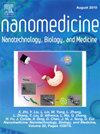谷胱甘肽反应性多肽纳米凝胶包封紫草素用于乳腺癌治疗。
IF 4.6
2区 医学
Q2 MEDICINE, RESEARCH & EXPERIMENTAL
Nanomedicine : nanotechnology, biology, and medicine
Pub Date : 2025-02-01
DOI:10.1016/j.nano.2025.102802
引用次数: 0
摘要
利用肿瘤微环境独特的生理生化特性,开发一种能够响应这些特定特性的多肽纳米凝胶作为一种有效的抗肿瘤策略具有很大的前景。在本研究中,我们通过一步开环聚合合成了谷胱甘肽响应(gsh响应)甲基化聚乙二醇-聚苯丙氨酸-聚胱氨酸嵌段共聚物(mPPC)。将紫草素(SHK)包封在纳米凝胶中,标记为mPPC/SHK。mPPC具有生物相容性和安全性,通过增强渗透性和滞留效应,促进其在肿瘤部位的积累,从而在高浓度GSH刺激下有效释放SHK。正如预期的那样,mPPC/SHK组对肿瘤的抑制作用增强,在4 T1乳腺癌模型中,肿瘤抑制率为69.97 %。总之,这种包封SHK的gsh响应多肽纳米凝胶作为一种有效的肿瘤纳米治疗药物具有巨大的潜力。本文章由计算机程序翻译,如有差异,请以英文原文为准。

Glutathione-responsive polypeptide nanogel encapsulates Shikonin for breast cancer therapy
Exploiting the unique physiological and biochemical characteristics of the tumor microenvironment, the development of a polypeptide nanogel capable of responding to these specific properties holds great promise as an effective antitumor strategy. In this study, we synthesized a glutathione-responsive (GSH-responsive) methylated poly (ethylene glycol)-poly (phenylalanine)-poly (cystine) block copolymer (mPPC) through one-step ring-opening polymerization. Shikonin (SHK) was encapsulated within nanogel, designated as mPPC/SHK. The biocompatible and safe nature of mPPC facilitated its accumulation at the tumor site through enhanced permeability and retention effect, leading to efficient release of SHK upon stimulation by high concentrations of GSH. As anticipated, the group of mPPC/SHK displayed enhanced efficacy against tumors, resulting in a tumor inhibition rate of 69.97 % in the 4T1 breast cancer model. Overall, this GSH-responsive polypeptide nanogel encapsulating SHK has tremendous potential as a promising biomedical agent for effective tumor nanotherapy.
求助全文
通过发布文献求助,成功后即可免费获取论文全文。
去求助
来源期刊
CiteScore
11.10
自引率
0.00%
发文量
133
审稿时长
42 days
期刊介绍:
The mission of Nanomedicine: Nanotechnology, Biology, and Medicine (Nanomedicine: NBM) is to promote the emerging interdisciplinary field of nanomedicine.
Nanomedicine: NBM is an international, peer-reviewed journal presenting novel, significant, and interdisciplinary theoretical and experimental results related to nanoscience and nanotechnology in the life and health sciences. Content includes basic, translational, and clinical research addressing diagnosis, treatment, monitoring, prediction, and prevention of diseases.

 求助内容:
求助内容: 应助结果提醒方式:
应助结果提醒方式:


